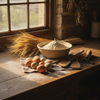Beyond the Fork and Spoon: Global Eating Customs
The humble fork and spoon—those trusty sidekicks that help us navigate everything from Monday's leftover pasta to Saturday's ambitious soufflé. But have you ever considered how these everyday tools vary across cultures? Or how your choice of utensil might be telling a story about who you are as a cook and eater?
At DI ORO, we're obsessed with kitchen tools that transform cooking from a chore into an adventure. While our award-winning spatulas might steal the spotlight (hello, America's Test Kitchen champion!), today we're diving into the fascinating world beyond the spatula—where the fork and spoon reign supreme in dining traditions around the globe. If you're ready to upgrade your own kitchen utensils, be sure to browse our Kitchen Utensils collection for tools that blend tradition with innovation.
The Fork and Spoon Revolution: More Than Just Eating Tools
Before we jet-set around the world, let's appreciate the revolutionary impact these simple tools have had on human history. The fork—that multi-pronged wonder—didn't actually become a standard dining tool in Western culture until the 16th century. Before that? Fingers and knives did most of the heavy lifting at mealtime.
Imagine trying to impress your dinner guests while stabbing at your food with a dagger! Not exactly the sophisticated dinner party vibe most of us are going for. The introduction of the fork transformed dining from a somewhat barbaric necessity into an art form—allowing for more delicate manipulation of food and, let's be honest, significantly cleaner fingernails.
Eastern Origins, Western Adoption
While many assume the fork is a Western invention, it actually gained early popularity in the Byzantine Empire before making its way to Italy through royal marriages. Talk about influential in-laws! Meanwhile, spoons have been with us since prehistoric times, evolving from shells and carved wood to the sleek metal versions we use today.
What's fascinating is how these tools reflect our values around food. Just as you might choose a DI ORO spatula because you care about what touches your food (forever-chemical free, anyone?), cultures worldwide have developed eating implements that reveal their unique relationship with meals.
Around the World with Fork and Spoon

If you've ever walked into a fork and spoon restaurant specializing in global cuisine, you've likely encountered different utensil traditions. Let's take a quick tour of how these tools vary worldwide:
The Asian Chopstick Mastery
In many East Asian countries, the fork and spoon take a backseat to chopsticks—though Thailand presents a fascinating hybrid approach. Thai diners typically use a spoon as the primary utensil, with a fork serving as the supporting player to push food onto the spoon. It's a beautifully efficient system that might leave you wondering why you've been doing it differently all along!
Next time you're checking out a fork and spoon menu at your local Thai restaurant, notice how the dishes are designed with this eating style in mind—typically cut into bite-sized pieces perfect for the spoon-and-fork technique.
The Indian Subcontinent's Hand Techniques
Across much of India, Pakistan, and Bangladesh, the most sophisticated utensil is the one you were born with—your right hand. Using bread as a scoop and your fingers with practiced precision, this method creates a sensory connection with food that metal utensils simply can't replicate.
It's not just about tradition—eating with your hands allows you to feel the temperature of your food, adjust the perfect bite-sized portion, and mix flavors exactly as you prefer. There's a mindfulness to it that many Western dining practices could learn from. For further reading on eating customs in different cultures, see this guide from the University of Rhode Island: Global Food Customs.
European Fork Etiquette
Even within Western traditions, fork usage varies. Americans typically practice the "cut and switch" method—cutting food with a knife in the right hand, then switching the fork to the right hand to eat. Meanwhile, Europeans keep their fork in the left hand throughout the meal.
Neither approach is "correct"—they're simply different cultural adaptations that have evolved over time. Just like how some home chefs swear by silicone spatulas while others can't imagine life without their wooden spoons (though we might gently suggest that our forever-chemical-free silicone is the healthier choice!).
Looking for a "fork and spoon near me" restaurant to explore these global traditions? Stay tuned for part two of our series, where we'll recommend restaurants that offer authentic cultural dining experiences—utensils and all! For more on global food consumption patterns and how they are shifting, check out this USDA article: Patterns of Global Food Consumption.
Cultural Significance of the Fork and Spoon
The fork and spoon aren't just tools—they're cultural artifacts that tell stories about our values, traditions, and relationships with food. When you're flipping pancakes with your DI ORO spatula (yes, the one America's Test Kitchen can't stop raving about), you're participating in a long tradition of humans creating specialized tools to enhance our culinary experiences.
What's fascinating is how these everyday implements reveal our deepest cultural assumptions about dining. Just as DI ORO believes what touches your food matters (which is why we're forever-chemical free), different cultures have developed unique approaches to the humble fork and spoon that reflect their culinary philosophies.
The Middle Eastern Bread and Spoon Technique
Across the Middle East, bread serves as both food and utensil, with spoons reserved for stews and rice dishes. The right hand typically manages the bread-scooping technique, while a spoon might assist with more liquid-based dishes. This approach minimizes waste (the bread soaks up delicious sauces) while creating a communal dining experience that strengthens social bonds.
Much like how the perfect spatula brings families together around weekend pancakes, these traditional eating methods create moments of connection around the table. There's something beautifully efficient about a system that's been refined over thousands of years.
When Fork and Spoon Meet Modern Innovation
While traditional utensil use continues worldwide, modern chefs and restaurants are reimagining the fork and spoon for contemporary dining. Many fork and spoon restaurant concepts now embrace fusion approaches, with menus featuring dishes designed for cross-cultural utensil experiences.
Take the popular Korean corn dogs trend—traditionally eaten by hand but now often served with a fork in Western settings. Or consider how many fork and spoon menu items at fusion restaurants thoughtfully include instructions on the "recommended" way to enjoy each dish.
The Psychology Behind Our Utensil Preferences
Did you know your utensil preferences might reveal something about your personality? Research suggests that people who prefer forks tend to be more methodical and detail-oriented, while spoon enthusiasts often approach life more holistically. It's similar to how some home chefs meticulously follow recipes while others (like many DI ORO customers) fearlessly experiment with new techniques.
This psychological connection explains why many of us feel slightly uncomfortable when forced to eat with unfamiliar utensils. That momentary awkwardness using chopsticks for the first time? It's not just about manual dexterity—it's about stepping outside your culinary comfort zone. For a deeper dive into the science and psychology behind eating utensils and habits, see this article: Eating Habits Across Cultures.
The Sustainable Future of Forks and Spoons
As we become more environmentally conscious, our relationship with everyday utensils is evolving. Many fork and spoon restaurants now offer biodegradable options, while home chefs increasingly invest in high-quality, durable utensils designed to last decades—not unlike DI ORO's lifetime-guaranteed kitchen tools. Discover our eco-conscious Best Sellers for sustainable additions to your kitchen.
This shift toward sustainability mirrors what we've seen in the spatula world. Just as our customers choose DI ORO for both performance and health benefits, diners increasingly seek eating implements that align with their values—whether that's traditional silver passed down through generations or modern eco-friendly alternatives.
Creating Your Own Utensil Traditions
The beauty of being a home chef in today's global kitchen is the freedom to create your own traditions. Perhaps you use chopsticks for noodles, fingers for tacos, and that special set of forks and spoons for Sunday dinner. Like cooking itself, how we eat should bring joy and express creativity.
At DI ORO, we believe kitchen tools should solve problems while adding delight to your cooking journey. The same philosophy applies to your dining implements—they should make eating easier while enhancing the sensory experience of each bite.
Finding Your Perfect Fork and Spoon Balance
Whether you're searching "fork and spoon near me" for a new global dining adventure or setting your table for a dinner party, consider how your utensil choices shape the dining experience. The weight of a quality fork, the perfect curve of a well-designed spoon—these details matter just as much as the food itself.
Like choosing between a spatula and a spoonula for the perfect pancake flip (hint: our award-winning Seamless Series has you covered either way), selecting the right utensils for each meal is part of the art of cooking and dining. It's another opportunity to bring intention and joy to your culinary adventures. Explore the Seamless Series to find tools that elevate your kitchen rituals.
In the final installment of our series, we'll explore how professional chefs think about utensils, share tips for teaching children global eating customs, and offer suggestions for building a versatile utensil collection that prepares you for any culinary journey—whether you're hosting an international dinner party or simply wanting to experience your favorite foods in new ways.
The Professional Chef's Approach to Utensils
Professional chefs have a fascinating relationship with the fork and spoon, often approaching these tools with the same reverence they give to their knives. In restaurant kitchens worldwide, you'll find chefs using specialized spoons for plating, tasting, and creating the perfect swoosh of sauce. Much like how DI ORO's Seamless Series spatulas (the ones America's Test Kitchen crowned champions) become extensions of your hand in the kitchen, a chef's personal spoon becomes part of their culinary identity.
"The right utensil changes everything," explains Chef Maria Sanchez of the acclaimed Fork and Spoon restaurant in Chicago. "It's not just about function—it's about how the weight and balance affect the entire eating experience." This philosophy mirrors our approach at DI ORO, where we obsess over the perfect balance between flexibility and strength in every kitchen tool we create.
Teaching Children Global Eating Customs
Introducing children to diverse eating styles does more than expand their culinary horizons—it develops cultural awareness and fine motor skills. Start with these approachable activities:
- Host a "global utensil night" where everyone tries a new eating implement
- Practice chopstick skills using cereal or small candies before attempting noodles
- Explore finger-food traditions from India or Ethiopia with child-friendly recipes
- Compare how different utensils change the experience of eating the same food
Children who grow comfortable with various eating styles develop confidence in diverse social situations. Plus, they're less likely to be the adult desperately searching "fork and spoon near me" when invited to an international restaurant!
Building Your Global Utensil Collection
Just as DI ORO enthusiasts build their collection of kitchen tools one piece at a time, curating a thoughtful set of global dining implements creates new possibilities in your home kitchen. Beyond the basic fork and spoon, consider these additions:
Essential Global Utensils
- Chopsticks: Look for training sets for beginners and high-quality reusable sets for regular use
- Thai soup spoons: Perfect for enjoying not just Thai cuisine but any broth-based dish
- Injera scooping technique tools: Small bowls and serving platters designed for Ethiopian dining
- Korean spoon and chopstick sets: Typically featuring a long-handled spoon specifically designed for their cuisine
When searching for authentic utensils, look beyond the fork and spoon restaurant supply stores to specialty importers and global markets. The difference between tourist-grade and authentic implements is substantial—much like the difference between a bargain-bin spatula and a DI ORO kitchen tool designed to last a lifetime.
Hosting a Global Dining Experience
Ready to put your utensil knowledge into practice? Host a dinner party that celebrates dining traditions from around the world. Create a fork and spoon menu that intentionally incorporates different eating styles, perhaps starting with finger foods from the Mediterranean, moving to chopstick-friendly Asian courses, and finishing with desserts best enjoyed with specialized spoons.
Provide brief, non-patronizing guidance for guests unfamiliar with certain techniques. Remember how DI ORO tools come with just enough instruction to make you successful without overwhelming you? Apply that same philosophy to your dining guidance—offer just enough information to build confidence.
The Future of Dining Implements
As global cuisines continue to cross-pollinate, we're seeing fascinating innovations in utensil design. The traditional boundaries between fork and spoon are blurring, with hybrid implements gaining popularity. Meanwhile, ancient eating tools are being rediscovered and adapted for modern dining—much like how DI ORO has reimagined classic kitchen tools with modern, health-conscious materials.
Whatever the future holds, one thing remains constant: how we eat profoundly shapes our experience of food. The perfect fork and spoon pairing, like the perfect kitchen tool, removes barriers between you and culinary joy.
Your Personal Utensil Philosophy
As we conclude our exploration of global eating customs, consider developing your own utensil philosophy. Which implements bring you joy? Which make certain foods more delicious or accessible? Just as you've chosen DI ORO tools that align with your cooking style and values, your dining implements should reflect your personal approach to food.
Perhaps you're a minimalist who prefers one perfect set of utensils for everything. Maybe you're a collector who delights in having the perfect implement for every cuisine. Or possibly you're a pragmatist who simply wants tools that work without fuss (in which case, you've already discovered why DI ORO's "it just works better" approach has earned such a devoted following).
Whatever your preference, remember that utensils, like all tools, should serve both function and joy. They should solve problems while adding delight to your culinary journey—whether you're flipping pancakes with America's Test Kitchen's favorite spatula or savoring soup with a perfectly balanced spoon.
The humble fork and spoon may seem ordinary, but they connect us to thousands of years of human ingenuity and cultural expression. And that's something worth celebrating, one delicious bite at a time.
Frequently Asked Questions
table manners how to place spoon and fork after eating
When you have finished eating, proper table manners dictate placing your spoon and fork together on your plate, parallel to each other, usually in the 4 o’clock position. This signals to servers that you are done with your meal. The handles should rest on the rim of the plate, and the tines of the fork and the bowl of the spoon should face upward.
how to keep spoon and fork while eating
While eating, rest your spoon and fork on the edge of your plate or bowl when you pause, with the handles resting on the rim and the working ends inside the plate. Avoid placing them directly on the table to maintain cleanliness and proper etiquette. This also signals to servers that you are still eating.
what does the spoon fork and knife mean in a persimmon
In folklore, cutting open a persimmon seed and examining the shape inside is said to predict the upcoming winter. If the shape inside looks like a spoon, it means heavy, wet snow; a fork suggests a mild winter; and a knife predicts a cold, cutting wind. This is a fun tradition rather than a scientifically based method.
what side does fork and spoon go on
Traditionally, the fork is placed on the left side of the plate, while the spoon goes on the right. If you are using a knife, it also goes on the right side, between the plate and the spoon, with the blade facing the plate. This arrangement is standard in Western table settings.
how to set fork knife and spoon on table
To set fork, knife, and spoon on the table, place the fork to the left of the plate, the knife to the right with the blade facing inwards, and the spoon to the right of the knife. If there are multiple courses, utensils are arranged in the order of use, from the outside in. Make sure all handles are aligned at the bottom for a neat appearance.
how to set up fork knife and spoon
Set up the fork on the left side of the plate, the knife on the right with its blade facing the plate, and the spoon to the right of the knife. For formal settings, additional utensils may be added depending on the courses, always in the order they will be used. Ensure everything is evenly spaced and straight for an elegant look.
where do you put the fork knife and spoon
The fork goes on the left side of your dinner plate, while the knife is placed on the right with the cutting edge facing the plate, and the spoon sits to the right of the knife. This placement is standard in Western dining and helps guests know where to find each utensil. Dessert spoons or forks may be placed above the plate.
do you eat mac and cheese with a spoon or fork
Mac and cheese is usually eaten with a fork, as this allows you to pick up both the pasta and the cheese sauce easily. However, some people may use a spoon, especially for creamier, runnier versions. Ultimately, it comes down to personal preference and the dish's consistency.
how to set up spoon fork and knife
To set up the spoon, fork, and knife, place the fork to the left of the plate, the knife to the right with the blade facing toward the plate, and the spoon to the right of the knife. This classic arrangement is used for both formal and informal settings. Make sure the bottoms of all utensils are aligned for a tidy presentation.
how to keep spoon and fork after eating
After finishing your meal, place your spoon and fork together on your plate, parallel and pointing to the 4 o’clock position. This is a universal signal to the server that you are done eating. Keeping them together also helps prevent them from falling off the plate during clearing.
what is a spoon and fork together called
A spoon and fork combined into one utensil is called a 'spork.' The spork typically has the bowl shape of a spoon with the tines of a fork at the end, allowing it to function as both. It's a handy tool often used for picnics, camping, or convenience dining.




